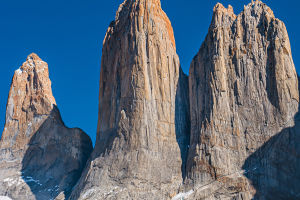The Andes is a majestic mountain range located in South America, stretching along the western coast for approximately 7,000 kilometers (4,300 miles).
It is the longest continental mountain range in the world, encompassing seven countries: Venezuela, Colombia, Ecuador, Peru, Bolivia, Chile, and Argentina.
Geologically, the Andes are the result of the collision between the Nazca and South American tectonic plates. This ongoing process has shaped the landscape, giving rise to towering peaks, deep valleys, and dramatic cliffs. The highest peak in the range is Aconcagua, located in Argentina, which stands at an impressive 6,960 meters (22,837 feet) above sea level.
The Andes boast a remarkable ecological diversity, with various ecosystems and microclimates. From snow-capped peaks to lush valleys, the range is home to a wide range of flora and fauna. The mountains provide a habitat for unique species that have adapted to extreme conditions, such as the vicuña, a camelid found in the high-altitude grasslands.
The cloud forests and montane forests harbor diverse plant species, including the iconic quinoa, potatoes, and numerous medicinal plants.
Furthermore, the Andes play a crucial role in regulating the climate of the surrounding regions. The mountains act as a barrier, influencing wind patterns and precipitation. They are also the source of numerous rivers, including the Amazon and the Orinoco, which provide water for millions of people and support rich ecosystems downstream.
The melting glaciers of the Andes contribute to the water supply, making them a vital resource for agriculture and human consumption.
The Andes hold immense cultural significance for the indigenous peoples who have inhabited these lands for centuries. The region is home to a diverse array of indigenous groups, each with its languages, traditions, and customs.
The ancient Inca civilization thrived in the Andes, leaving behind remarkable architectural wonders such as Machu Picchu in Peru. The ruins of ancient cities and temples are a testament to the ingenuity and craftsmanship of these ancient cultures.
Today, the Andes continue to be a hub of cultural expression and traditional practices. Indigenous communities maintain their ancestral knowledge, preserving traditional farming techniques and weaving skills. Festivals and ceremonies celebrate their cultural heritage, showcasing vibrant music, dance, and colorful costumes.
Travelers have the opportunity to immerse themselves in these rich cultural experiences, gaining a deeper appreciation for the Andean way of life.
The Andes also attract adventurers and nature enthusiasts from around the world. Hiking and trekking routes, such as the famous Inca Trail, offer breathtaking views and the chance to explore remote corners of the mountains.
Mountaineers test their skills on challenging peaks, while wildlife enthusiasts seek out elusive species in the pristine wilderness. The Andes provide endless opportunities for outdoor exploration and adventure.
However, the Andes face various challenges, including environmental degradation and climate change. Deforestation, mining, and urbanization pose threats to the delicate ecosystems and cultural heritage of the region. Climate change is affecting the Andes as well, with rising temperatures and receding glaciers impacting water availability and biodiversity.
Efforts are underway to protect and preserve the Andes. Conservation organizations and governments are working together to promote sustainable tourism, protect biodiversity hotspots, and support indigenous communities in their efforts to maintain their traditional practices.
Initiatives focused on reforestation, renewable energy, and climate change adaptation are also being implemented to mitigate the challenges faced by the Andes.
The Andes is not only a remarkable natural wonder but also a testament to the resilience and diversity of the South American continent. Its towering peaks, rich biodiversity, and vibrant cultures make it a truly unique and awe-inspiring region


